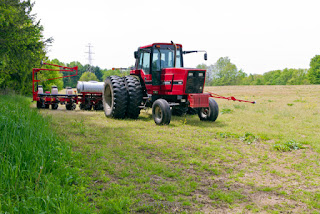 |
| 17-Year Cicada After Molt |
This cicada has molted, crawled out of its skin. It is extremely vulnerable during the time immediately following the event.
 |
| 17-Year Cicada After Molt |
It must remain supported by its legs and feet while it pumps fluid into the wings. Since the creature has no internal skeleton like we do, it must wait as all external parts, exoskeleton, solidify before it can use them. This shot shows the wings on one side which are yet to be pumped. The ones on the back side have enlarged (see below).
 |
| 17-Year Cicada After Molt |
 |
| 17-Year Cicadae |
Once they can fly, they land everywhere. They "sing" their mating call and mate. When the eggs are fertilized within the female, she places them inside a split cut by her sharp ovipositor into an young leaf stem.
 |
| Dead Leaf |
The leaf dies because of the insertion but the eggs hatch into nymphs (first instar).
 |
| Nymph Emergence Holes |
They burrow down and live among the roots of woody plants for 17 years until they have passed through the requisite number of instars until they are mature nymphs. At that time (17 years later) they emerge though holes like the ones shown in the trail above.
Credits: This information comes from Wikipedia and Field Guide to Insects and Spiders, National Audubon Society, 1980, Chanticleer Press, Inc.
Larry's Images and Aerial
Follow Larry's Images on Facebook.
If you wish to unsubscribe, email to larry@larrysimages.com with "unsubscribe" in the subject line.
Follow Larry's Images on Facebook.
If you wish to unsubscribe, email to larry@larrysimages.com with "unsubscribe" in the subject line.




